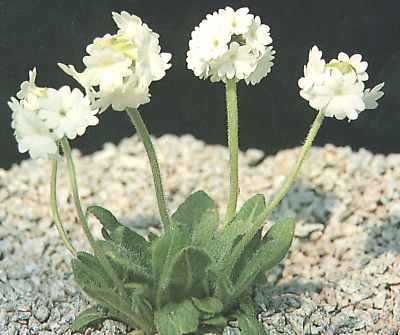 |
Plant Portrait : Primula buryana |
| Home Recommend This Site To A Friend |
|
by Fred Carrie
Native to central and eastern Nepal, this soldanelloid primula has been introduced and subsequently lost from cultivation on several occasions. The most recent introduction was by seed collected by Alastair McKelvie and Chris Chadwell (CC&McK144) in the Dhaulagiri region in 1990. We were fortunate enough to obtain some of this seed and managed to raise a number of plants. P. buryana is a beautiful little plant with a neat rosette of soft hairy leaves and stems of scented white funnel-shaped, often rather flat- faced, flowers arranged horizontally around the top of a 5 to 10 cm stem. The plant is most certainly worth growing but is invariably short-lived. We tried our plants in several locations with mixed results. In terms of longevity the most successful planting was in a deep trough. No protection of any kind was given at any time and the plants grew and flowered well. Alas no seed was set despite having pin and thrum eyed plants growing side by side. The least successful was without doubt in clay pots in an alpine house. By spring 1993 plant numbers were dwindling fast and no seed had been set. Careful hand pollination that year gave a reasonable seed-set and allowed us to produce a second generation although we lost most of the original plants in the process. We have not, as yet, managed to produce enough plants to distribute widely and although we are now into our third generation of seed, two abnormally hot summers have taken their toll of the stock plants. We have heard that other growers have had similar problems and that the number of plants left in cultivation is likely to be very small. From our successes and failures with this plant we would draw the following conclusions. The plants are likely to be short-lived so hand pollination is vital to ensure seed set and a succession of new plants. Although not considered monocarpic, the plants may well die if seed is set. It is therefore necessary to have a reasonable number of plants to ensure continuity. The seed germinates well. Seed stored in a fridge for 6 months before sowing actually produced more seedlings than seed that was sown straight from the plants. The seedlings should be pricked-out as early as possible in spring straight into 7cm pots. The compost we use is a mix of 2 x peat, 1 x J.I. no.3 and 1 x 5 mm granite grit with the addition of a little slow-release fertiliser. The young plants must be kept in a cool north facing frame as any direct sun is likely to prove fatal at this stage. During hot periods an adequate supply of water and some form of shading is essential. Early pricking out will ensure a long growing period in the first year and will produce strong plants which should survive the following winter. Protect the over-wintering buds with glass while ensuring adequate ventilation. Using this method it is probable that a few plants will flower in the autumn of their first year. However, no seed is likely and the plants do not seem to be weakened by this. In their second spring, the larger plants can be potted on into one litre plastic pots. They should be kept in these pots and have a permanent home in a cool north facing frame. As flowering begins, select an assortment of pin and thrum eyed plants, take them into a cool greenhouse and cross-pollinate. The plants should then be protected from the worst of the weather until the seed is collected. It is best not to pollinate all of your plants in the same year as many are likely to die if seed is set. Since this article was first published in 1996, we have lost this plant. Speaking with other growers who had it in reasonable numbers, the story is always the same. It was lost during abnormally hot summer weather, it only takes a momentary lapse in attention at the wrong time and they are gone. However we feel that much has been learned since the CC&McK 144 introduction in 1990 and that if a little more seed could be collected, this plant could become permanently established in cultivation. On two trips to Central Nepal I was unable to find any plants to collect seed from - it can be like looking for a needle in a haystack. ^ back to the top ^ |
